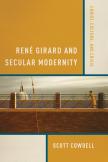How Everything Hangs
A new Darwin, indeed one who does a better job of explaining who and what we are than even Sigmund Freud? Someone who offers a key to all the mythologies? And, even in this age of secular modernity, one who offers an intellectual synthesis that actually holds faith, reason and science together? That one can answer yes to these questions and point to the work of one person, the French-American anthropologist and cultural critic René Girard, is the bold claim of this book.
What enables Cowdell to make this claim is the extraordinary explanatory power of Girard’s mimetic theory, a theory that finds in the way human beings instinctively imitate the desires of others the fundamental dynamic that characterizes all human social, religious and political activity. Originally brought to light from a reading of the world’s great literature, and then confirmed by a reading of the Bible, the universal applicability of this theory has also been supported by recent discoveries about imitative behavior in cognitive neuroscience.
Key to this theory is Girard’s understanding of the archaic sacred, the mechanisms of sacred violence. This applies especially to the scapegoat mechanism, which formerly protected us from our self-destructive mimetic urges but now, having been progressively unveiled by secular modernity, is becoming increasingly ineffective in doing so.
One of the unique and controversial aspects of this theory is the claim that it is the Bible, and more precisely Christianity, that is primarily responsible for the secularization that indeed liberates us from the shackles of the “false sacred” but also, ironically, from the scapegoat mechanism that we have been using to save ourselves from the effects of our rivalrous desires.
But this liberation is incomplete; enough of the archaic sacred perdures in our world to continue to make violently sacrificial readings of the Bible still possible, as, e.g., in “Christian fundamentalism whose angry God underpins a myth of redemptive violence in American culture.”
In a central chapter, “Modern Institutions and Violence,” Cowdell spells out how the archaic sacred helped pre-modern societies to protect themselves from constant violent disruptions by maximizing “external mediation” and limiting “internal mediation.” In the external mediation of desire, for example, peasants did not think of themselves as equal to their lords and masters and thus possibly their rivals. But with the onset of equality and its concomitant dilution of religious authority, secularized modernity in the West has had to rely on the nation state and, more recently, the market to control and divert, distract and dilute the violent conflictual mimesis of internal mediation (everybody equal to everybody else) that equality seems to make inevitable.
In a final chapter, “War, Terror, Apocalypse,” Cowdell expounds Girard’s vision of this emancipation of mimetic desire from traditional constraints as moving us inexorably toward a situation of absolute war, a situation better understood, Girard claims, not just in terms of the West versus Islam, but as a global civil war based on the erasure of difference.
Far from being just another in a long series of jeremiads, Girard’s apocalyptic fears and Cowdell’s measured description of Girard’s listing of the actual phenomena and events leading to this unhappy end, this Girardian vision does not leave us without a sliver of hope. For even though we cannot keep ourselves from imitating someone else’s desire, that same dynamic can be not just the deadly cancer but also the healing cure.
That begins to happen when the desire that we imitate is, for example, the kenotic (i.e., self-giving, self-emptying) desire of Jesus. According to Girard and especially his Christian interpreters and followers, in that kind of dynamic—not restricted to Christians, as the life of Ghandi shows, and admittedly not well supported by the bloodstained history of the Christian church—violent, acquisitive mimesis is replaced by a nonviolent transformative mimesis.
How powerfully transformative that can be is illustrated by what happened to St. Ignatius, the founder of the Jesuits. Driven no longer to imitate the glorious feats of knights and warriors but the self-giving desire and feats of Jesus and the saints, Ignatius’ life was transformed. The daunting question with which the more recent work of Girard leaves us is: will enough of this kind of transformation be taking place in our world to counteract a seemingly inevitable slide toward global civil war?
The strength of this book is the chilling clarity with which it explains the origins and the dynamic operations of human civilization as we know it, and the profound internal threats to that civilization that have been developing in secular modernity.
The weakness of the book is that it is not an easy read, not even for those already open to Girard’s vision. But it does reward the persistent reader with a remarkable sense of how everything hangs together. And it actually achieves this to an extent that, to my knowledge, no other theory can claim. The persistent reader will be rewarded with a comprehensive glance into the “key to all the mythologies” that George Eliot’s Edward Casaubon so vainly sought and that, somewhat later, Nietzsche glimpsed but could not bring himself to accept. For, as Cowdell notes in his opening words, appreciation of this theory requires a certain amount of personal conversion, although, as the extraordinary range of Girard’s followers indicates, not necessarily conversion to Christianity or even to religion.
In other words, this is a good book on a very, indeed vitally important subject.
This article also appeared in print, under the headline “How Everything Hangs,” in the October 14, 2013, issue.








